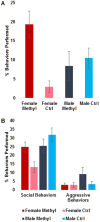Pleiotropic effects of a methyl donor diet in a novel animal model
- PMID: 25121505
- PMCID: PMC4133251
- DOI: 10.1371/journal.pone.0104942
Pleiotropic effects of a methyl donor diet in a novel animal model
Abstract
Folate and other methyl-donor pathway components are widely supplemented due to their ability to prevent prenatal neural tube defects. Several lines of evidence suggest that these supplements act through epigenetic mechanisms (e.g. altering DNA methylation). Primary among these are the experiments on the mouse viable yellow allele of the agouti locus (A(vy)). In the Avy allele, an Intracisternal A-particle retroelement has inserted into the genome adjacent to the agouti gene and is preferentially methylated. To further test these effects, we tested the same diet used in the Avy studies on wild-derived Peromyscus maniculatus, a native North American rodent. We collected tissues from neonatal offspring whose parents were fed the high-methyl donor diet as well as controls. In addition, we assayed coat-color of a natural variant (wide-band agouti = A(Nb)) that overexpresses agouti as a phenotypic biomarker. Our data indicate that these dietary components affected agouti protein production, despite the lack of a retroelement at this locus. Surprisingly, the methyl-donor diet was associated with defects (e.g. ovarian cysts, cataracts) and increased mortality. We also assessed the effects of the diet on behavior: We scored animals in open field and social interaction tests. We observed significant increases in female repetitive behaviors. Thus these data add to a growing number of studies that suggest that these ubiquitously added nutrients may be a human health concern.
Conflict of interest statement
Figures




Similar articles
-
A high methyl donor diet affects physiology and behavior in Peromyscus polionotus.Physiol Behav. 2019 Oct 1;209:112615. doi: 10.1016/j.physbeh.2019.112615. Epub 2019 Jul 9. Physiol Behav. 2019. PMID: 31299371 Free PMC article.
-
Diet-induced hypermethylation at agouti viable yellow is not inherited transgenerationally through the female.FASEB J. 2007 Oct;21(12):3380-5. doi: 10.1096/fj.07-8229com. Epub 2007 Jun 5. FASEB J. 2007. PMID: 17551099
-
Differential spontaneous transformation in vitro of newly established mouse fibroblast lines carrying or lacking the viable yellow mutation (Avy) of the mouse agouti locus.Mol Carcinog. 1996 Jan;15(1):70-80. doi: 10.1002/(SICI)1098-2744(199601)15:1<70::AID-MC10>3.0.CO;2-1. Mol Carcinog. 1996. PMID: 8561869
-
The molecular basis for dominant yellow agouti coat color mutations.Bioessays. 1994 Oct;16(10):705-7. doi: 10.1002/bies.950161002. Bioessays. 1994. PMID: 7980472 Review.
-
Choline, Other Methyl-Donors and Epigenetics.Nutrients. 2017 Apr 29;9(5):445. doi: 10.3390/nu9050445. Nutrients. 2017. PMID: 28468239 Free PMC article. Review.
Cited by
-
Nutrition, metabolism, and epigenetics: pathways of circadian reprogramming.EMBO Rep. 2022 May 4;23(5):e52412. doi: 10.15252/embr.202152412. Epub 2022 Apr 12. EMBO Rep. 2022. PMID: 35412705 Free PMC article. Review.
-
Microarray analysis reveals higher gestational folic Acid alters expression of genes in the cerebellum of mice offspring-a pilot study.Brain Sci. 2015 Jan 26;5(1):14-31. doi: 10.3390/brainsci5010014. Brain Sci. 2015. PMID: 25629700 Free PMC article.
-
Maternal Melatonin Therapy Attenuates Methyl-Donor Diet-Induced Programmed Hypertension in Male Adult Rat Offspring.Nutrients. 2018 Oct 2;10(10):1407. doi: 10.3390/nu10101407. Nutrients. 2018. PMID: 30279341 Free PMC article.
-
High Gestational Folic Acid Supplementation Alters Expression of Imprinted and Candidate Autism Susceptibility Genes in a sex-Specific Manner in Mouse Offspring.J Mol Neurosci. 2016 Feb;58(2):277-86. doi: 10.1007/s12031-015-0673-8. Epub 2015 Nov 7. J Mol Neurosci. 2016. PMID: 26547318
-
A high methyl donor diet affects physiology and behavior in Peromyscus polionotus.Physiol Behav. 2019 Oct 1;209:112615. doi: 10.1016/j.physbeh.2019.112615. Epub 2019 Jul 9. Physiol Behav. 2019. PMID: 31299371 Free PMC article.
References
Publication types
MeSH terms
Grants and funding
LinkOut - more resources
Full Text Sources
Other Literature Sources
Medical

